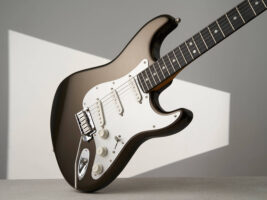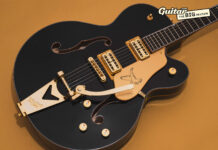
Fender American Ultra II Stratocaster review – the shreddiest Strat ever?
$2,199/£2,259, fender.com
Fender’s American Ultra II range is designed – as previously noted – to cater to the needs of the most demanding professional players. The original Fender Ultra concept was released back in 2019 replacing the Elite Series, but the Ultra name actually dates back over 30 years – the original Ultra Strat debuted in 1990 and remained in the line-up until 1998.
READ MORE: Fender American Ultra II Meteora – is this Fender’s most impressive guitar of 2024?
The fundamental ethos remains the same; a guitar designed using premium components that meets the needs of the modern professional, or as Fender put it: “the ‘sports car’ of the Fender lineup… “catering to both traditionalists and those exploring new, faster, and more intricate playing styles.”
Image: Adam Gasson
Fender American Ultra II Stratocaster – what is it?
Much about the Ultra II range is – perhaps unsurprisingly – in keeping with the five-year-old original Ultra series. So you get the same enhanced rear body contours – here rechristened as ‘Ultra Contours’ natch – and tapered neck heel to enhance playability. You also get the same 10-14” compound radius, medium jumbo (not stainless steel frets) and a similar array of Noiseless pickups, locking tuners, two-point vibrato and stainless steel block saddles.
The biggest new addition to the Ultra II is probably the neck itself, which is now made of quartersawn maple. For the uninitiated, a quartersawn neck is milled from logs so that the tree’s annual growth rings are perpendicular to the broad face of the boards. This makes for a tighter grain on the resulting lumber, giving straight parallel lines that run the length of the ‘board.
The benefits derived from this method are both aesthetic and practical – the straight grain greatly improves the neck’s strength and stability, and is less susceptible to the dreaded shrinkage that many of us experience on a seasonal basis.
There are other new features too – notably adding Luminlay side dots for improved visibility on dark stages, replacing rosewood with ebony for the darker-hued fingerboards, and adding short posts to the locking tuners.
Aesthetically, there are brushed aluminium scratchplates in various colours across the range and there’s also a bunch of new finishes – although the ‘Texas Tea’ here has already proved a hit on the original Ultras. Now it’s paired with a silver anodised aluminium scratchplate rather than the Ultra I’s gold. Texas Tea is a shade that could easily be described as metallic brown, which now that I’m writing it, I can understand why they didn’t!
Image: Adam Gasson
Fender American Ultra II Stratocaster – playability and feel
One of the big claims about the Ultra II is that this new quartersawn neck is its fastest and most shred-ready ever. At first grip, the D-shaped neck is perhaps slightly slimmer than those I’ve experienced on other contemporary American Strats, which have themselves often been a fairly slim C when compared to USA necks of old. But in this instance what it may lack in girth is made up for by an ample set of shoulders which prove supportive of over-the-thumb chord work.
The flatter back will of course be a favourable feature for those thumb-behind-the-neck technical players. Particularly noteworthy is the neck’s wonderful satin urethane finish, which has possibly the smoothest, silkiest feel I’ve ever experienced – in this regard it certainly lives up to the ‘fastest’ label.
Much like, say the Pattern-thin carve on a PRS Custom, the neck doesn’t appear to fatten a great deal as you travel further up the neck, which my digital callipers confirm. I find this a little counter-intuitive, even for shredders, given that your hand naturally requires further support higher up the neck. I’m sure Fender has done its research on this, and perhaps I’m in the minority on this one, but personally I’d have liked to have had more support at the top end.
The newly rechristened Ultra contours, especially those near the neck heel, are a testament to what Fender wants to achieve with this guitar. Previous attempts to improve upper-fret access have always felt rather half-hearted, but the Ultra’s skinner neck heel coupled with the sculpting behind both horns makes getting to those high frets even more accessible than ever on a Strat. In conjunction with the masterfully rolled fingerboard edges and smooth ebony ‘board, traversing the length of the neck is incredibly efficient.
Image: Adam Gasson
Fender American Ultra II Stratocaster – sounds
Plugging in, I’m immediately struck by the different sonic palette that ebony brings to the table. Being the most popular guitar in history, and thus having an instantly recognisable sound, any tweak to the tried and tested formula is going to be immediately noticeable – and perhaps divisive.
In this case, the ebony ‘board makes a marked contribution to the brightness of the tone, and through my clean Fender Deluxe Reverb I’m immediately met with a more concentrated treble to the tone. Despite contrasting colours, ebony perhaps has more in common with maple than rosewood in terms of character, and some would consider it a little bit brighter.
On the bridge setting this brightness is exacerbated, to the level where I’m compelled to dig out my rosewood-boarded Custom Shop Strat just to check that I’m not hearing things. Much to my chagrin, there’s not a great deal of difference between the two in the treble department on the bridge pickup – instead it’s a reminder of just how bright and treble-y a Strat’s bridge position single-coil can be if you’ve not spent much time there recently…
Image: Adam Gasson
Where the Ultra really stands out is when you add some gain to proceedings – here our comparison really favours the Ultra II. It’s far superior to the CS Strat, and is perhaps where the Noiseless aspect is most beneficial and apparent, as the signal is uber-clean. Perhaps more striking though is the fact that the natural spanky character of single coils is not lost but in fact emphasised due to the absence of noise. These pickups don’t appear to dull the high end like other noiseless pickups from other brands – I’d go so far as to say that it’s my best experience of the noiseless single-coil technology to date. No wonder so many pros have positive things to say about them.
I’m a little less positive about the S-1 switching system. When Fender’s much-vaunted multi-stage wiring control was launched back in 2003 it promised, “a near-endless array of pickup options at your fingertips”. Two decades later and it seems that the “endless array” has been stripped back to er… two.
Hitting the switch on the tone control with the volume control in position 1 links the bridge and neck in parallel, while position 2 activates all three pickups in parallel. Contrast that with the fact the old American Elite Strat offered no less than five additional wiring options with the S-1 switch engaged – including various series and out-of-phase options. Maybe Fender has decided that players didn’t want all that… but it feels a bit undersold with just two sounds here.
Image: Adam Gasson
Fender American Ultra II Stratocaster – should I buy one?
The whole point of the Ultra II range is to appeal to the most demanding player. As someone who has a technical approach to guitar, but has remained forever in love with a Strat since they first owned one in 2005, the Ultra II certainly holds its own against more shred-ready S-type guitars from the likes of Ibanez or Tom Anderson.
The impressive thing is that the Ultra II Strat isn’t just for shredders – if you’re a blues-rock guitarist who wants to crank things up in the manner of SRV, you’ll find this a hugely accommodating partner. And once you do, that instant gratification will be enhanced by the fact that, due to the compound radius, your strings simply will not choke.
My main complaint is probably the defaulting to ebony fingerboards – I prefer the look and feel of rosewood, but it’s probably quite a subjective issue. This incarnation of the Ultra will certainly give its boutique competitors a run for its money – it’s Fender’s most shredder-friendly Strat to date.
Fender Ultra II Stratocaster – alternatives
There’s plenty of competition for the Ultra II Strat in this price range and the Ibanez AZ series continues to be a popular choice amongst shredders looking for Super S-types. The Ibanez Prestige AZ2204N ($1,999/£1,749) with its roasted maple neck and HSS configuration certainly fits the bill. A little pricier but another firm favourite for the S-type shredder is the Suhr Classic (from $3,449), with a myriad of different options available. At half the price of the Ultra is the signature model of arguably the most virtuosic single-coil-based player out there right now: the Schecter Nick Johnston Traditional which comes in at the relatively bargain price of $899/£849.
The post Fender American Ultra II Stratocaster review – the shreddiest Strat ever? appeared first on Guitar.com | All Things Guitar.
Source: www.guitar-bass.net











